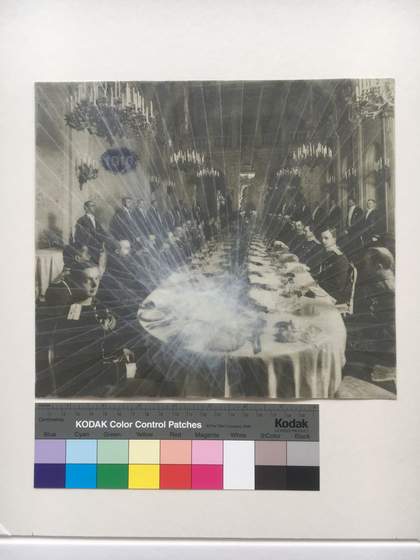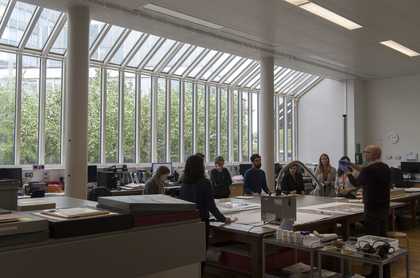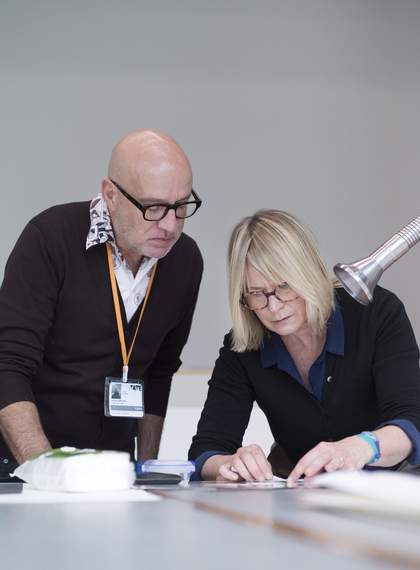Pressure sensitive tapes (PSTs) can be widely found on library and archive materials as well as on paper-based works of art. They can be added to an object as part of a conservation treatment for repairing tears, assembling and fastening together detached pieces of a document or of a drawing, or as a mounting material.
When working with modern and contemporary paper-based artworks, however, it is not unusual to find examples where PSTs have been applied directly by the artist, incorporating them among their materials and practice. In this case, the PSTs become part of the artwork and need to be preserved.

One of the drawing produced by Dmitri Prigov from the series Scotch Tape Drawings c.1999–2002, Tate Collection (T14446). The ballpoint pen drawing over a printed magazine reproduction of a photograph dating from the early twentieth century was completely covered by the artist with several overlapping strips of transparent adhesive tape. Photo © Tate
The presence of PSTs on works on paper can cause damage (both physical and chemical) to the substrate and media over time, thereby compromising the appearance of the object. The deterioration of PST is well known to conservators, in particular for rubber-based tapes that over time can leave disfiguring staining on the paper support, lose adhesion, and ultimately lose the carrier and their structural function. In addition, the removal of PSTs still poses several challenges to conservators, often remaining impossible.
This is one of the conservation challenges being addressed by the NANORESTART project. Paper conservator Antonio Mirabile and a team of scientists from CSGI in Florence (project partner and project leader respectively) spent the last three years researching and developing new strategies to address this issue. Some of the outcomes of are now available through publications1 2 and were presented by Antonio Mirabile through a two-day training course held at Tate Britain on 30 April and 1 May 2018. The course was structured to provide theoretical information in the morning, with a practical session in the afternoon. The first day focussed on an overview of PSTs, including their history and development, and their degradation over time.
PSTs have a multi-layered structure and generally consist of: an adhesive, a backing or carrier, a primer coat (used between the adhesive and the baking to ensure good contact between the two) and a release coating (to ensure an easy unwinding of the tape during the application). The materials used to make each component have changed over time; the adhesive was initially made of natural rubber, which has been progressively substituted by synthetic rubber, such as styrene-butadiene (SBR), and can also contain softeners, plasticizers, fillers or antioxidants. The backing can be made of foil, crepe paper, fabric, cellophane, cellulose acetate, plasticized polyvinyl chloride or polypropylene. Depending on the materials they are made off, PSTs respond differently to environmental conditions (i.e. relative humidity, temperature, illumination) and have various degradation pathways, resulting in different impacts on the paper substrate(s) and media.
Rubber-based adhesives are characterised by a three-step degradation process. During the initial period, which is called induction time, they start to oxidise and the backing becomes yellow. As the ageing process progress, the adhesive starts to yellow and loses its consistency, becoming more sticky and oily, penetrating into the substrate, making it translucent, and becomes transferred onto adjacent sheets. The carrier may also fall off. In the final stage, adhesive residues crosslink and become hard and brittle. The removal of PST(s) becomes exponentially more difficult depending on the degradation phase, with the cross-linked adhesive residues proving most difficult to remove.
Acrylic-based adhesives follow a completely different degradation process; while they do not discolour as much over time, their adhesion strength increases over time, rendering them more difficult to remove. They are also subject to cold flow, which is the tendency of an adhesive to migrate (flow) at room temperature, and thus might migrate into the substrate depending on the porosity of the paper. Specific issues affecting the artwork’s media were also discussed – with a specific focus on contemporary inks such as ballpoint pen, felt-tip pen and printing inks – as the penetration of the adhesive or cold flow generally seen with acrylic-based tapes may cause migration, bleeding of the media.
The characterisation of each component and relative degree of deterioration is thus essential to guide the conservator in selecting the most appropriate strategies for removal. A visual examination and evaluation can be carried out through assessing the PST colour, texture and ageing state, i.e. discolouration, crystallisation, migration and penetration into the support. With the aid of analytical techniques – IR spectroscopy, Pyrolysis Gas Chromatography Mass Spectrometry (PyGCMS) and Scanning Electron Microscopy (SEM) – we can gain a better understanding of the chemical composition and structure of the PST. Antonio presented some examples and results for new, naturally and artificially aged commonly used PSTs (i.e. Filmoplast P, masking tape, Magic Tape, brown tape and ordinary tape); and several case studies he has encountered over his career. The first morning session then concluded with a discussion on the ideal environmental conditions to store paper-based artefacts with PSTs, with a particular emphasis on case studies where PSTs are part of the object.
The first afternoon session was dedicated to an open discussion about and practical demonstrations of established removal techniques, such as heat-induced methods (use of heated spatula or hot air pencil, use of mechanical erasers, neat solvents applied through poultices or onto suction points) and a summary of their inherent risks and limitations.

Paper conservator Antonio Mirabile (on the right) in Tate’s paper conservation studio during the Pressure Sensitive Tape Removal workshop, 30 April - 1 May 2018. Photo © Tate
The second day focused on the strategies developed within the NANORESTART project to tackle the challenges of PSTs’ removal. Starting with a discussion on the Teas diagram – a chart used by conservators to categorise solvents – and the inherent solubility of adhesives found in PSTs, participants were introduced to a range of materials, such as solvents and oil in water (O/W) microemulsions that have been identified as useful for PSTs’ removal.
Part of the research phase that led to the selection of these materials was also presented and another section was dedicated to the learning about the environmental impact of these materials.
Two novel approaches for PSTs removal were outlined. The first included the use of an oil in water microemulsion – i.e. droplets of an organic solvent that can soften the adhesive in the PST, dispersed in water via the addition of a surfactant, which was then confined within a highly retentive chemical hydrogel (a pHEMA/PVP scaffold). The combination of these two systems enabled safe and controlled removal of the PST, overcoming the risks faced using traditional methods. As part of a microemulsion, the solvent penetrated into the PST structure and softened the adhesive, without the risk of solubilising and spreading into the paper substrate which is typically the result when applying neat solvents. By confining the microemulsion within a retentive gel, the release of the former was controlled and limited to the area of contact between the gel and the substrate.
The second option was based on the use of a green solvent, i.e. diethyl carbonate, loaded in a chemical organogel (a gel that can confine an organic solvent), based on a PMMA/PEMA scaffold. Currently, CSGI and Antonio are working on optimizing the performance of the gel and are testing a new type of organogel.
The afternoon involved the application of these new strategies on a series of mock-up samples, where participants had the chance to handle and become familiar with these materials. During the demonstration, more information was also provided on potential drawbacks related to the use of both these methods, with an emphasis on when contemporary or sensitive media are present, including guidance on how to reduce or avoid these issues.

Paper conservator Antonio Mirabile (on the left) and Tate paper conservator Rosie Freemantle during a test with the chemical hydrogel loaded with the oil in water microemulsion. Photo © Tate
The family of poly(vinyl alcohol)-based hydrogels, known as Peggy gels and developed by CSGI as part of the NANORESTART project, were also presented to the group. Antonio discussed different ways he uses these gels for paper-conservation treatments beyond PSTs removal, once again providing useful tips for enhancing their performance.
The course was an excellent opportunity to broaden our knowledge on PSTs and the new strategies being used to remove them. The hand-on approach allowed participants to try promising solvents and all the range of gels that are being developed by CSGI, and we look forward to working with these materials in the future.
Valeria Duplat, Angelica Bartoletti and Bronwyn Ormsby, Tate
June 2018
